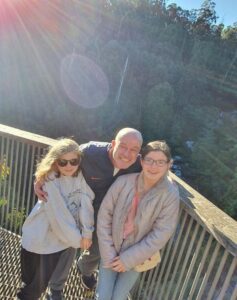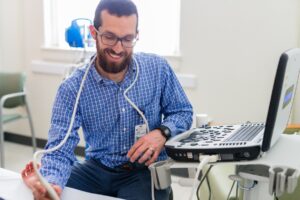By Lisa Farr, M.Ed. Director, Exercise Physiology Core Lab
Interview with Jason Allen, Ph.D, Professor, Kinesiology Department, Curry School of Education
Joaquin de Zavallos, MS, doctoral student, Kinesiology, Curry School of Education
Peripheral arterial disease (PAD) is caused by blockages in the arteries to the lower extremities. This results in poor circulation. Similar to coronary artery disease, which refers to blockage in the coronary arteries, PAD is more likely to occur in people with certain risk factors. Two of the most common risk factors for PAD are smoking and diabetes. Older age is also a risk factor for PAD, though some people are diagnosed before the age of 40.
PAD causes very significant pain and disability. The leg pain caused by PAD—typically described as burning, cramping pain– is called “claudication” and it can range from mild to excruciating. The typical pattern is that an individual will experience claudication in one or both legs with walking. The pain goes away by resting or avoiding activity. As the person avoids walking, their claudication threshold lowers; that is, they are able to do less without pain. It becomes a vicious cycle that can result in the person not being able to perform functions of daily living—walking to the store from the parking lot, for example—without having to stop and rest. One third of individuals report pain with light activity and another third can’t walk a city block without it. In some individuals, the pain continues to get worse until they can do virtually nothing without discomfort. At its worst, the pain is present at rest, wakes the person from sleep, and/or is associated with non-healing wounds. As circulation gets worse, the parts of the leg below the level of the blockage will continue to become more impaired, with a cascade of consequences that may include muscle wasting and inappropriate platelet aggregation (blood clots). Amputation is a feared complication of advanced PAD.
The goal of PAD treatment is to relieve pain, heal wounds, and improve quality of life and function. Medications for PAD have been largely disappointing. Surgical treatments, such as by-pass, angioplasty, and stenting, improve blood flow and help with these outcomes but have not been shown to effectively increase walking ability. Clearly then, there is dysfunction beyond just the narrowed artery and subsequent reduced blood flow since restoring blood flow doesn’t improve walking. What else is leading to the walking impairment? What might make it better?
This is where Jason Allen’s study comes in—exploring the mechanisms and seeing if supplementation with beetroot juice—will produce greater tissue perfusion, oxygen delivery, and enhanced muscle metabolism in comparison to placebo. They think that will translate into an increase in physical performance, including pain-free walking.
Why beet root juice? It’s an easy way to provide something called dietary nitrate consumption. In brief, Nitric Oxide (NO) is produced by the vascular endothelium and plays an important role in vasodilation, flow regulation and platelet function. Disruptions in the production of NO have been implicated in the pathogenesis of vascular disease. One potential therapeutic option to increase NO involves the conversion of inorganic nitrate (NO3-) and nitrite (NO2-) anions into NO (and other bioactive species). Inorganic NO3- is abundant in green leafy vegetables, celery, lettuce, radishes, spinach, beets, and beetroot juice.
Q and A with Jason Allen and Joaquin Ortiz de Zavallos
Question
Why did you want to study therapies for PAD patients?
Answer
Jason: As a soccer player, I planned to study Sports Physiology but decided early on I wasn’t that interested in working with athletes. I was much more interested in learning about clinical populations and studying how to help them. PAD is very debilitating, and life-limiting– we need additional strategies—we need to help people feel better and able to do more.
Joaquin: As a younger graduate student (at Exeter in England) I worked primarily with athletes. When I met Jason, and went with him to Australia as his Ph.D student, I was first introduced to clinical populations. I remember the first exercise test I assisted with—it was a subject with heart failure—I couldn’t believe it was over after just a few minutes! That was all the person could do. I saw the incredible need to help patients with clinical diseases do more. If you can only last a few minutes on a treadmill, the quality of your life is very impacted. If you can find ways to help people move better and remain more active, they are healthier, and more able to do the things in life they care about doing.
Question
So what is the real-life application of your study?
Answer
Jason: We hope that nitrates could offer another way to improve symptoms and quality of life for these patients. This study will help us understand the mechanisms and degree of improvement acutely. (ie over just a few days of supplementation) We are planning a larger study that will combine longer term supplementation with exercise rehabilitation. Maybe that combination will result in the best effects. It’s important that people have effective non-surgical options.
Study Specifics
Subjects ages 40 – 80 with PAD will be randomly assigned to drink beetroot juice or a look-alike placebo for 5 days and undergo a variety of tests, including MRI of the calf, to measure blood flow and vascular stiffness. They will also perform a treadmill test in which we track the onset of their leg pain, as well as how long they can walk before they have to stop due to maximal pain. Subjects will then “wash out” for 7 days and drink whatever they didn’t drink the first time (if they had placebo initially, now they will get beetroot juice) Subjects and investigators are blinded as to who is consuming what.
This study is funded by 3Cavaliers, which is a UVA program that supplies support for collaborative projects. This project is a joint effort between Dr. Jason Allen (Kinesiology), Dr. Craig Meyer (Biomedical Engineering) and Dr. Christopher Kramer, MD (Cardiology). It is IRB-HSR 21774.
While catching up with Jason and Joaquin we took the time to get a little personal too:
Question
Jason, what’s your exercise of choice?
Answer
“I’m a soccer player. I grew up playing in England and even got paid a little bit to play. But I quickly realized I had a little talent but mostly just worked really hard…there were people with more talent who also worked hard. But I love it and still play in the local above 40 league (fall and spring) and in the off season I try to stay soccer fit by running and lifting weights.”
Question
Joaquin, how about you?
Answer
“I am mostly into mountain biking right now. In the past I have done triathlons and longer races. When I get back into running more, it will definitely be trails. Running and biking in the woods requires complete attention—otherwise it’s too easy to hit a rock or root or otherwise have an accident. This is nice for disconnecting.”
Question
Joaquin, what advice would either of you give your younger self regarding exercise?
Answer
Be more responsible with injuries. Don’t train through pain…you’ll regret it.
Jason is from England, has 2 daughters, 2 kitties, and 2 dogs and has lived all over the world. He and his partner Jennifer have settled in the Crozet area.


